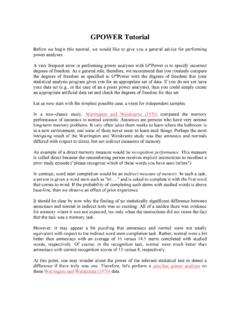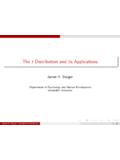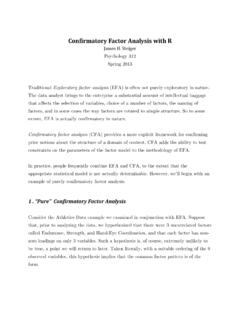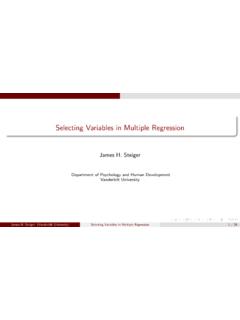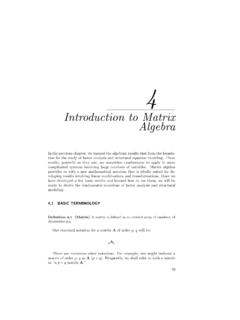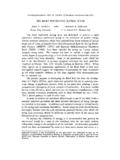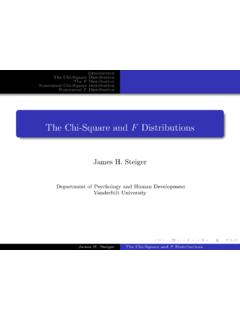Transcription of Summation Algebra - Statpower
1 2. Summation Algebra In the next 3 chapters, we deal with the very basic results in Summation Algebra , descriptive statistics, and matrix Algebra that are prerequisites for the study of SEM theory. You may be thoroughly familiar with this material, in which case you may merely browse through it. However, it is my experience that many students find a thorough review of these results worthwhile. SINGLE SUBSCRIPT NOTATION. Most of the calculations we perform in statistics are repetitive operations on lists of numbers. For example, we compute the sum of a set of numbers, or the sum of the squares of the numbers, in many statistical formulas.
2 We need an efficient notation for talking about such operations in the abstract. In the simplest situations, we have one or two (or perhaps three) lists, and we wish to refer to particular numbers in those lists. This is the kind of situ- ation you have probably already dealt with repeatedly in your undergraduate course in statistics. In this case, we represent numbers in a list with a notation of the form xi The symbol X is the list name, or the name of the variable represented by the numbers on the list. The symbol i is a subscript, or position indicator.
3 It indicates which number in the list, starting from the top, you are referring to. 9. 10 Summation Algebra . Student X Y. Smith 87 85. Chow 65 66. Benedetti 83 90. Abdul 92 97. Table Hypothetical Grades for 4 Students For example, if the X list consists of the numbers 11, 3, 12, 7, 19 the value of x3 would be 12, because this is the third number (counting from the beginning) in the X list. Single subscript notation extends naturally to a situation where there are two or more lists. For example suppose a course has 4 students, and they take two exams.
4 The first exam could be given the variable name X, the second Y , as in Table Using different variable names to stand for each list works well when there are only a few lists, but it can be awkward for two reasons. 1. In some cases the number of lists can become large. This arises quite frequently in some branches of psychology, when personality inventory data are recorded. In such cases, there might be literally hundreds of variables for each subject. 2. When general theoretical results are being developed, we often wish to express the notion of some operation being performed over all of the lists.
5 It is difficult to express such ideas efficiently when each list is represented by a different letter, and the list of letters is in principle unlimited in size. DOUBLE SUBSCRIPT NOTATION. To combat the difficulties that arise when more than one list is being discussed, it is often more convenient to use double subscript notation. In this notation, data are presented in a rectangular array. The data are indicated with a single variable name, and two subscripts, like this xij The first subscript refers to the row that the particular value is in, the second subscript refers to the column.
6 For example here x11 x12 x13. x21 x22 x23. x31 x32 x33. SINGLE Summation NOTATION 11. is a matrix, a rectangular array containing 3 rows and 3 columns. You count down to get to a particular row, and you count across from left to right to get to a particular column. Example Test your understanding of double subscript notation by finding x23 and x31 in the array below. Then, give the row and column subscript indices of the number 14 in the array. 1 6 32. 3 23 112. 12 21 34. 53 8 64. 4 14 5. Solution. Go down to the second row and over to the third column to find x23 = 112.
7 Go down to the third row and stay in the first column to find x31 = 12. We find the number 14 in the 5th row and the second column. Hence it is x52 . Note that, when there are more than 9 elements in a row or column, this notation can be ambiguous. Suppose, for example, you wanted the element from the 11th row and the 2nd column of a 20 by 20 data array. If you write x112 , it could mean the element in row 1 and column 12. How do you handle this? Oddly enough, you hardly ever see this question addressed in textbooks! Obviously you've got to do something.
8 Generally, anything goes in these kinds of situations so long as it is very unlikely that anyone will be confused. We have several options. One is to separate the subscripts with spaces, like this x11 2. Another option is to surround each subscript with brackets, like this x[11][2]. Unfortunately, this choice produces ambiguities of its own when adopted as a general choice, because in some types of expressions, the notation might imply multiplication of subscripts, while in other situations it would be per- fectly acceptable. Here is a notation that works well across a wide variety of situations x11,2.
9 This is the notation we will employ in situations where there are more than 9 rows and/or columns in a two-dimensional data array. SINGLE Summation NOTATION. Many statistical formulas involve repetitive summing operations. Conse- quently, we need a general notation for expressing such operations. You may 12 Summation Algebra . be already familiar with this notation from an undergraduate course, but you may not be aware of its full potential. We shall begin with some simple ex- amples, and work through to some that are more complex and challenging. Many Summation expressions involve just a single Summation operator.
10 They have the following general form N. X. xi i=1. In the above expression, the i is the Summation index, 1 is the start value, N. is the stop value. Summation notation works according to the following rules. 1. The Summation operator governs everything to its right. up to a natural break point in the expression. The break point is usually obvious from standard rules for algebraic expressions, or other aspects of the notation, and we will discuss this point further below. 2. To evaluate an expression, begin by setting the Summation index equal to the start value.
